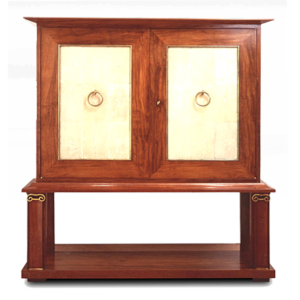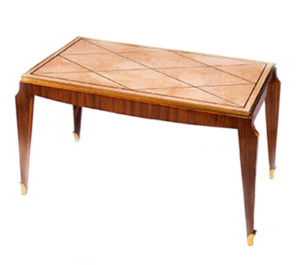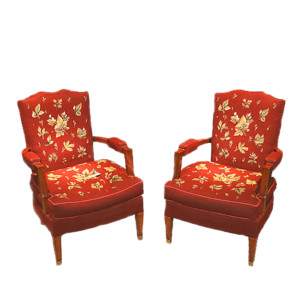(1903-1996)
Jean Pascaud is one of the most influential furniture and interior designers of the twentieth century. Today, Pascaud’s work appears ultramodern, but during his time, his style was considered more traditional, and embraced both traditional and contemporary ideas.
Pascaud was born in Rouen, in 1903. He graduated in 1924 from the Ecole Centrale des Arts et Manufactures, with a degree in engineering. Despite earning an engineering degree, Pascaud was interested in the decorative arts.
This interest in the decorative arts guided Pascaud into designing furniture, and later, in the late 1920s, into interior design. His father-in-law, Auguste Bluysen, President of the Societe des Architectes Modernes, encouraged Pascaud’s design work, and in 1927, Pascaud designed his first pieces of furniture.
Once Pascaud, had entered the field of furniture design, he began to exhibit his work in various salons, including Salon des Tuileries, Salon d’Automne, and Salon des Artistes Décorateurs.
Like his contemporaries André Arbus, Paul Dupré-Lafon, and Jacques Adnet, Pascaud was a traditionalist. His furniture, without a signature or documentation, can sometimes be difficult to differentiate from that of Royère, Arbus, Dominique, or Pascal. Pascaud’s style was concerned with simplicity and technical virtuosity, which worked together to communicate both contemporary and traditional taste. Pascaud soon moved away from the Modernist style that was popular during the 1930s, and believed that the history of furniture, both past and future, depended on both originality and proven design. He is known for his use of rich veneers and exotic woods, including violet wood, palisander, and American walnut, which were often embellished with parchment and galuchat for luxury, or metal banding for dramatic contrast. He also made use of sculptural gilded central medallions in the manner of Ruhlmann.
Pascaud displayed his controlled, conservative furniture in an environment that provided it with an essential, warm setting. For example, in 1935, Pascaud presented his furniture in a bedroom that was lined in mauve fabric, with doors lacquered in gold, and linens and upholstery in grey silk. Pascaud’s goal was for the luxurious, traditional setting to compliment and showcase his work.
By the early 1930s, Pascaud had stopped exhibiting his work at the Salons, but continued his design work. He received the coveted Grand Prix at the International Expositionof 1937. Pascaud collaborated with many other designers, including Mme Bouissou (decorative glass panels), Pierre Lardin (engraved mirrors), and Léon Lang (paneling). By the 1940’s, Pascaud was a renowned designer and decorator, and had developed a prestigious clientele that ranged from government officials to private figures. He even received a commission for the ocean liners Pasteur and Normandie, which continued to increase his already high status as a designer and decorator.
In the 1950’s, Pascaud collaborated on the designs for the embassies of Sweden and Checkeslovakia, and also for the French Embassy in Mexico. In 1951, he was commissioned by the Mobilier National to design an ensemble for la tour Francois 1 in Rambouillet.
After an illustrious career, Jean Pascaud passed away in 1996.
Showing all 3 results




